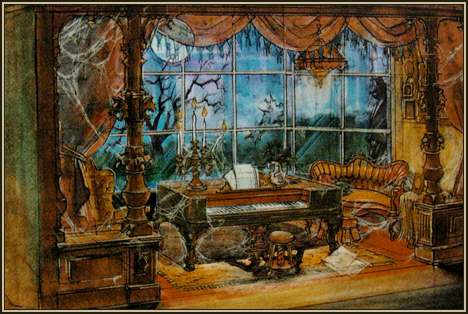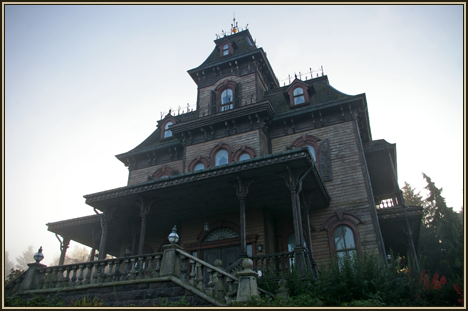
Happy Haunts Materialize
Under the supervision of Jeff Burke and his production designer Richard Brown, the Manor's interior show sets were built in London by the British firm of Ackland-Snow, known for their work for the BBC.
In order to fill the Manor with actual period items, Imagineer Ken Gomes collected antique props at auctions and sales all over the world. Real Persian carpets and ornate European furniture would lend a sophisticated authenticity to the sets. Special props that would tie the ride’s story and its haunted atmosphere with the period setting were being manufactured at the same time.
In the meantime, 10,000 construction workers were busy turning the Imagineers’ concepts into actual buildings and landscapes over in Marne-la-Vallée, France.
 Phantom Manor and Big Thunder Mountain under construction. Image courtesy of EuroSouvenirland. Phantom Manor and Big Thunder Mountain under construction. Image courtesy of EuroSouvenirland.
The OmniMover ride system was being manufactured in the Netherlands and Germany by companies such as Vekoma, who were also responsible for the track of neighboring Big Thunder Mountain.
Once basic construction was finished, Jeff Burke and his production designer Richard Brown flew over to oversee the installation of Phantom Manor’s show elements in the field. The bigger sets, like the Grand Staircase and Ballroom, were built in place by the carpenters and artisans of Ackland-Snow.
As the show scenes were nearing completion, Jeff Burke was asked to present the ride to a number of French park officials. Not knowing quite how to explain the show to them, he in turn asked Greg Meader to prepare a demo tape of the show’s soundtrack. The audio producer, who was still in the process of mixing the final show tracks over in California, recalls: “It was a total guess on my part as to how long to make each scene last as the actual ride vehicles had not yet been installed. There was no way to know how long you would actually be in each scene.”
Once he figured out the duration of each track, Greg Meader recorded the resulting mix on tape and sent it to Paris. “Jeff simply put the tape in a boom box on his shoulder and walked the officials through the ride letting the soundtrack do the talking.”
Ron Esposito was in charge of giving the building its dilapidated look. He took special care to make it look realistic as well as artistically pleasing. Reasoning that bad weather comes in from the East, Esposito and his team aged the right side of the facade more than the rest.
Meanwhile, the Audio-Animatronics characters, special effects and animated props were being coordinated and programmed. Greg Meader came over from California to install the audio and make some last-minute tweaks.
 Music Room concept art by Fernando Tenedora. © Disney. Music Room concept art by Fernando Tenedora. © Disney.
“Jeff and myself would ride the ride and decide that we needed to add some extra sound in order to help the transition from one scene to another.” In some cases, mechanical noises drowned out the recorded audio tracks, such as the haunted piano in the Music Room: “The air jets used to move the keys were so loud during installation that you couldn’t even hear the piano.”
One important change to the ride’s soundtrack would be made several months later, however... French cast members, perhaps tired of having to translate the narration for non-English-speaking guests, were pushing for the Phantom’s spiels to be replaced by a French-language recording. As Vincent Price’s original takes of the French script were deemed unusable, Jeff Burke and show writer Craig Fleming consulted Tony Baxter and Marty Sklar in order to find a solution.
After much deliberation, they hired Gérard Chévalier, a French actor who had already recorded several voices heard in the park and who, it turned out, had actually dubbed Vincent Price in the past, to re-record the spiels in French as originally intended. “But before we went into recording with Mr. Chévalier, it was decided that Craig and Thierry would craft a shorter, functional, less story-focused spiel,” Jeff Burke recalls. “I felt John Debney’s music was the real narrator of the attraction from the very first scene…”
Vincent Price’s signature laugh, however, would remain in the attraction. As Craig Fleming puts it, “Vincent’s fee for the recording session was ten thousand dollars, so you could say the Phantom has a ‘ten-thousand-dollar laugh.’”

Not long before the park’s Grand Opening, Tony Baxter took Michael Eisner on a tour of the park. Tony was slightly worried of what Disney’s CEO might think of the finished Phantom Manor, considering the departure taken from the previous Haunted Mansion rides. At the end of their tour, they finally approached the Manor and the Imagineer was braced for anything... Just then, Eisner’s teenage son was leaving the ride and enthusiastically shared with his dad that it was the best Haunted Mansion they had ever made. As it turned out, this was enough for the CEO to hear: he congratulated the relieved Tony Baxter and went on his way.
On April 12, 1992, at 9:01am, Euro Disneyland officially opened its doors and Phantom Manor, forty-one years in the making, received its first visitors...

|

